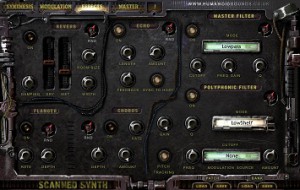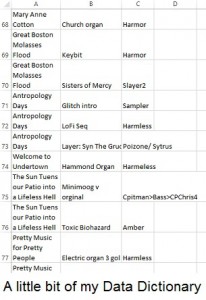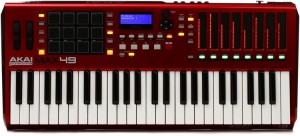I own gear, and you, gentle reader, have questions bout the gear I own. Here are the answers.
Q: What the Hell is the deal with the laptop? I paid to see a Punk Rock show, not a damn Science Fair.
A: There are two reasons why you didn’t see many (or any) computers onstage during the Hardcore Punk days: Their size and their cost. Back in the 1980’s, the average laptop weighed over 4 tons (that’s nearly 300 lbs.!) and had to be transported to gigs in a semi-trailer.

When you factor in the cost (most computer systems during the Reagan years ran upwards of several million dollars or “Ronnie Bucks” as they were known) and the Stage-Diver-Inverse-Ratio Law (The less coordinated the stage-diver, the more likely he or she will land on your most expensive piece of equipment), you can see why use of computers was prohibitive to Punk bands.
Over the years, both keyboards and computers have become lighter and less expensive. The first synth I ever used onstage was my beloved Yamaha DX11, which I believe I paid about $300 for in 1988. It weighed about 15 lbs. and I owned it up until one night in 2008 when I hurled it, along with myself, into the crowd at Fun Fun Fun Fest.

The good news is that during an episode of Big Questions with the Dead Milkmen I bemoaned the loss of DX 11 and a kindly viewer contacted me to say that he owned one that he couldn’t get to function. He very generously gifted me the synth and I brought it back to life by replacing the internal battery (which was not fun fun fun)
You can see my repaired DX11 along with a bunch of other synthy-stuff in this video:
My DX11 was soon joined (in my home studio, not in the crowd) by an Alesis HR-16 drum machine, an Alesis MMT-8 sequencer (nobody owned one without owning the other), and a rack-mounted Ensoniq EPS 16+ sampler (in its case, it weighed about 90 lbs). Believe it or not (and I’ll understand if you don’t), this, along with a Yamaha mt100 4-track recorder was my home studio setup until roughly 2010.
Q: Thanks for the history lesson, dude. Really. But what’s the deal with the laptop?
A: I was getting to that. Although I had been strictly using hardware since the the late 80’s, sometime during the mid-to-late 90’s I began experimenting with DAWs. I think the one I used the most was a freebie that came on a disk with an issue of Computer Music Magazine.
Anyway, since I’d been in the IT business for a over a decade at that point, I figured that I should make the leap to a software setup. The free DAW had some great built-in soft synths, but it wouldn’t run on my new desktop. so I began experimenting with other DAWs. Some had great VSTs, but had crappy workflows; others had great workflows, but the VSTs were useless. Then, one day, I stumbled upon what was intended to be a negative review of FL Studio in the comments section of a article on Synthtopia. Basically, the comment read “FL Studio is for Punks and maybe for Goths – people who just want to have fun making noise. It isn’t for serious musicians.” That seemed like a really positive statement to me. I think I came on-board around FL Studio 8. As of this writing (Feb 2024), I’m using FL Studio 21.
I used to be an FL Studio “power user” along with artists like Zardonic and Tristam (which is kinda weird if you think about it) but I’ve since been stripped of that honor 🙁
So nearly every musical (and un-musical) sound I’ve made on the the last two Dead Milkmen albums, as well as all of my solo, collaborative, and remix work has been produced by a VST [This is why I have to keep a “Data Dictionary” : a spreadsheet showing which VST, patch, sample, and/or FX plugin for every song I play – even the covers. For example, that’s a a Hammond organ patch from Harmless on “Welcome to Undertown“], and the majority of these VSTs are from FL Studio. Just about the only exception is a wonderfully strange VST called Scanned Synth.

I use Scanned Synth quite a bit in my solo work – it makes weird and frightening sounds.

Q: So, if all of the sound, including the “farty” ones, come out your laptop, why do you have an amp on stage?
A: That’s a good question. And one I recently asked myself. The answer is that, although my Roland JC -120 Jazz Chorus is a great amp there is no damn reason for me to have it onstage. Basically it functioned as a giant monitor, but since most of the clubs I play in have decent monitors, it’s just really taking up space (when not in us as an amp, it function as a piece of furniture in our living-room) . And that’s why I’m no longer using it.
Last Halloween, the Milkmen played a show with Ego Likeness; during Ego’s sound-check I noticed that Mindcage Rick played his guitar through a pedal-board, sans amplifier. I think this will be the wave of the future for bands. So, I’ve jettisoned my amp from my live setup and now I use a Novation Audiohub 2×4.

This is thing is so fuggin’ kewl that I’ve incorporated it into my DJ setup. It allows me run my laptop, controllers, and cooling pad (the value of which I learned from Bryan & Christof of Velvet Acid Christ) form one piece of hardware. Also, it’s louder than Mike Huckabee shouting obscenities at an blind orphan’s crippled puppy.
Q: Not so fast, me bucko! If the music comes out of the laptop, why do you have a keyboard onstage? Huh? Huh? Where’s your God now, Moses?
A: The keyboard is a controller. It doesn’t produces any sound, it just controls the laptop in much the same way as pressing a key on a piano triggers a hammer that strikes the tiny man who lives in the piano, forcing him to sing.
I’ve had several controllers, but my current one of choice is an Akai Max Pro 49. i like it because it has pads which allow me to play percussive sounds and samples while I play the keys, and because it has banks of sliders which allow me to do links like control the X & Y axes (yes, that’s the plural of “axis”) of patches. Also, it looks like a Hot Wheels.

Q: Do you have any advice for musicians who are just starting out?
A: Yes. Two pieces of advice, actually. The first is read EVERY interview with Gary Numan that you can. Gary has never made a bad album, and he has some great things to say about gear (Gary isn’t sentimental about his synths – he simply uses what works best.
The second is please what this video about time management starring my friend ZooG (the guy in the Dead Milkmen t-shirt) from Angelspit. This video changed how I work on music.
